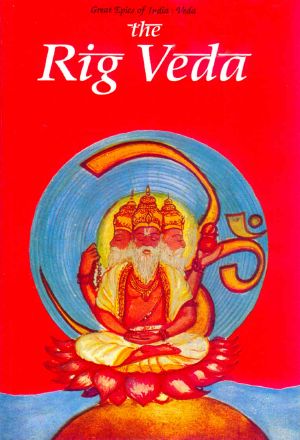Rig Veda (Great Epics of India · Vedas Book 1)

- Authors
- Debroy, Bibek & Debroy, Dipavali
- Publisher
- B.R. Publishing Corp.
- Tags
- religion , philosophy , spirituality , history , poetry
- ISBN
- 9788176465298
- Date
- 1994-10-21T00:00:00+00:00
- Size
- 0.16 MB
- Lang
- en
The Vedas are ancient texts that are sacred in India and renowned the world over. The world veda literally means Knowledge. The root is vid, ‘to Know’ The Vedas are thus texts that provide Knowledge.
There are four Vedas, known as the Rig Veda, the Yajur Veda, the Sama Veda and the Atharva Veda. Many years ago, the Vedas were referred to as trayi or three. There must have been some point of time when there were only three Vedas. These are acknowledged to have been the Rig Vedas, the yajur Veda and the Sama Veda. The Atharva Veda is believed to have a later addition to the sacred canon.
The world trayi is also interpreted in a different sense. Although the interpretation does seem to be slightly artificial, it is following. The three paths to salvation are believed to be those of jnana (Knowledge), bhakti (devotion) and karma (action). Since the Vedas teach these three paths to salvation, they are referred to as trayi. The Rig Veda is identified with the path of knowledge, the yajur Veda with the path of action, and the Sama Veda with the path of devotion.
Each of the Vedas has two parts, a samhita and the brahmanas. The samhita part consists of mantras or incantations. These were hymns that were used in sacrifies. But these mantras are difficult to interpret without commentaries. This is what the brahmanas set out to do. They explain the hymns and indicate how these are to be used in sacrifices. The brahmanas also have detailed descriptions of sacrifices and how they are to be conducted. The samhita and the brahmanas are often known as karma kanda, that is, the part of the Vedas that deals with rituals.
In addition Vedic literature also includes jnana kanda. This is the part that deals with supreme knowledge. Included in jnana kanda are the aranyakas and the Upanishads. These are identified with various Vedas.
We can therefore have a narrow definition of a Veda as well as a broad one. The narrow definition would take the word Veda to mean the samhita alone. The broad definition would include, in addition associated brahmanas, aranyakas and Upanishads. By the word Veda, we will mean the samhita alone.
When were the Vedas composed and who composed them? Strictly speaking, there is no answer to these questions. The Vedas were revealed; they were shrutis. They were not written down or composed. They were communicated by the supreme godhead or the divine essence (brahman) to the ancient seers (rishis). These rishis did not compose the Vedas; they merely obtained this divine knowledge through their extraordinary powers. In this sense, the Vedas are apourusheya, that is, not the handiwork of men. Their authorship cannot be ascribed to any human author.
In the Hindu conception of time, time is divided into four eras. These are known as satya yuga, treat yuga, dvapara yuga and kali yuga. As one moves from satya yuga towards kali yuga, the power of righteousness diminishes and evil starts to rear its ugly head. To bring men back to the righteous path, the sacred knowledge that is in the Vedas must be disseminated amongst them. But the Vedas are abstract and esoteric, often difficult for ordinary mortals to comprehend. To make the dissemination and assimilation easier, the Vedas must be conveniently partitioned and divided into various groups. A person who thus divides (vyasa) the Vedas has the title of Vedavyasa or Vyasadeva conferred on him.
In every dvapara yuga, such a Vedavyasa is born to perform this sacred task, The Vedavyasa born in the dvapara yuga tha immediately preceded the present kali, yuga, was Krishna Dvaipayana Vedavyasa. It is he who is credited with having divided the original unified Vedas into the four segments of the Rig Veda, the yajur Veda, the Sama Veda and the Atharva Veda. Krishna Dvaipayana Vedavyasa did not compose the Vedas, he merely recapitulated what was already known. Incidentally, Krishna Dvaipayana Vedavyasa is also credited with the composition of the great epic, the Mahabharata.
Just as it is impossible to determine who composed the Vedas, it is also impossible to determine when they were composed. Widely different dates have been suggested by scholars. Tilak suggested a date of around 6000 B.C., while Jacobi’s date was around 4500 B.C. Most scholars would agree that the Vedas were compiled some time between 4000 B.C. and 1000 B. C. and that it is impossible to narrow down the range further. The earliest of the Vedas is clearly the Rig Veda. This reached a stage of final compilation between 1000 B. C. and 900 B. C.